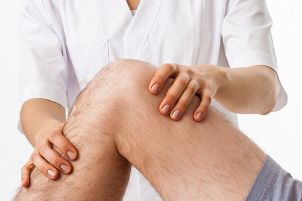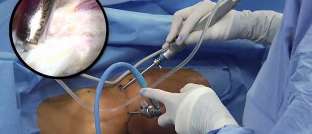What a diagnosis of "knee osteoarthritis"
We talk about the disease, where the cartilage is damaged and destroyed. Cartilage, because of the dense fabric, which acts as a shock absorber any contact, it is necessary for its movement. After the breakdown of the cartilage of the joint gradually loses mobility, but if the disease is not treated, then completely ceases to work. However, in the early stages of osteoarthritis can be effectively treated with medication and physical therapy.

By the way, About 12% of young people suffer from arthritis, and retirement, this figure is more than half — a quarter of all parents complain of the symptoms of this disease.
Women suffer from osteoarthritis more often than men.
The risk group also includes athletes active training and micro trauma to the cartilage often lead to limited joint mobility at a young age.
There is evidence that osteoarthritis is some genetic predisposition. If you have a family had the disease case, you should carefully monitor the condition of the joints.
The causes of the disease
Reasons for the development of osteoarthritis a lot. These are:
- trauma and micro trauma to the joints;
- excess weight is an additional burden on the knee joint;
- metabolic disorders in which the cartilage is missing essential nutrients;
- unbalanced load during physical work or too intensive training;
- dysfunction of the circulatory system, which impaired nutrition of the cartilage tissue;
- prolonged spasms of blood vessels in the legs. The extent of knee OA and symptoms
Knee osteoarthritis develops gradually.So, there are several degrees of this disease.
1 degree. At this stage the changes are still small and can even loosely determined by instrumental surveys. To develop osteoarthritis of the indicative symptoms, such as mild stiffness of the joint after long immobility (often in the morning) and crunching in the joint when sudden movements. Severe pain is usually there, so people often ignore these signs and go to the doctor only when knee comes up 2. stage.
2 the degree of Joint deformation, x-rays, a significant narrowing of the joint space, and deformed cartilage. Symptoms become pronounced — patients complain of constant pain, which increases at the beginning of the movement, restriction of mobility of the noticeable stiffness in the morning. Small effort (eg. lifting) also cause pain. Sometimes the skin over the joint turns red, swells a little and warm to the touch — this indicates the development of inflammation. Osteoarthritis of the knee 2. degree patients report increased pain when the weather changes or after exposure.
3. degree. Severe osteoarthritis of the knee is characterized by severe pain in all movements, lameness, and sometimes marked shortening of the limb. The common area is greatly swollen, and in the morning, people just can't get out of bed — sometimes you have to wait half an hour before the movement is partially restored. When 3. the degree of osteoarthritis of the knee joint cartilage significantly thinner, and in some places entirely destroyed, so that the bones touch each other.
4 degrees. The complete destruction of the cartilage, excruciating pain and immobility — it is what you get, if you don't ignore the signs of osteoarthritis to the last. The common space is lost and it starts the deformation of the bones. Diagnostics when the first stage of treatment
If you suspect disease, you should immediately make an appointment to see a doctor and podiatrist, who diagnosed him.
The diagnosis of osteoarthritis is associated with laboratory and instrumental methods.
The first is the General and biochemical blood and urine analysis. These tests help to exclude autoimmune disease that leads to loss of joints, determine the presence of inflammation.
Instrumental methods of diagnosis of osteoarthritis most often used as a simple radiography in two projections, ultrasound, computed tomography, magnetic resonance imaging.
Methods of treatment of osteoarthritis
Osteoarthritis of the knee is treated, but the prognosis is very favorable. if treatment is started as early as possible in the 1-2 stages of the disease. Many treatment methods, but only a holistic treatment will give the desired result.
One of the most effective methods for shock waves, medical treatment, tensile joints, intra-articular administration of drugs, muscle toning and physiotherapy (physical therapy).
Drug treatment
Help only deal with the symptoms.
Non-steroidal anti-inflammatory drugs
to reduce inflammation and pain.
chondroprotectors
contribute to nutrition of articular cartilage. Supplement widely used in creams and gels with the analgesic effect, as well as external funds to relieve inflammation and improve blood microcirculation.
UHT
Shock wave therapy — the method by which the therapeutic effect is achieved by the effect of sound wave on the tissue of the joint. This is a relatively painless procedure, which, however, allows to achieve impressive results — to relieve pain, destroy and soften the calcium deposits (osteophytes), improves metabolic processes in tissues, normalizes blood circulation and relieve swelling, the language of ordinary people — "clean up" the joint. The effectiveness of treatment reaches 90%.
Physiotherapy
Therapeutic exercise — is almost a necessary part of the treatment of osteoarthritis of the knee. exercise therapy is a special exercises carefully calculated load and water therapy exercises, which are performed in specialized medical devices. Physiotherapy can help to restore joint mobility, improve blood circulation, to develop and strengthen the ligaments.
Summary of the joints
Bet, or bet the joints is performed with a special orthopedic apparatus. This method extends to the joint and extends in a common space, thereby reducing friction of the articular surfaces and the patient's joint is unloaded. A positive effect was observed in 80% of cases.
Intraarticular injections
How to drain excess fluid, and injection of pharmaceuticals — anti-inflammatory, analgesic and improves blood flow to the articular cartilage of drugs, etc.
It is necessary to tell such a method, since the injection in your patient's plasma nerve growth factors contained in plasma. They speed up recovery and regeneration of damaged articular cartilage. The advantage of PRP is that on its own the plasma is not allergies, this is a safe biological stimulator of regeneration. 2-3 months after a course of PRP, patients note that the pain and stiffness is reduced by half, and the mobility of the joint improved.
Muscle toning
Method of treatment based on stimulation of the muscles of the microcurrents. If arthrosis of the knee joint is atrophy of the thigh muscles, impaired blood circulation. This dramatically increases the load on the joints.
The stimulation helps to strengthen these muscles, which relieves the load on the joint, improve blood circulation, to form a solid frame connection.
Surgery

arthroscopic debridment. The method used for removal of common elements destroyed cartilage, meniscus part. The surgery is performed with video-control. Internal prosthesis. If the joint is completely destroyed, it can be replaced with artificial. Internal prosthetic resorted to only in the most severe cases, a third or fourth stage of the disease.
The new knee will last 12-15 years. Timely diagnosis of osteoarthritis it is important not to pull and not to postpone visit to the doctor, and self-medicate using over-the-counter remedies.
Osteoarthritis develops gradually, but some of the people between the first symptoms of the disease and time to save the joint can only function when only a few years — it all depends on the individual. In most cases, early diagnosis and comprehensive approach to treatment can manage the symptoms of arthritis and restore joint.













































